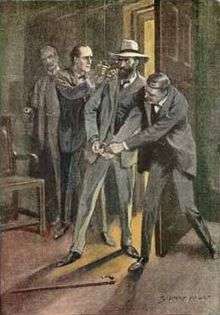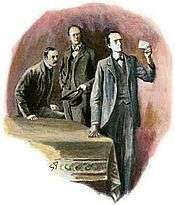The Adventure of the Dancing Men
| "The Adventure of the Dancing Men" | |
|---|---|
|
Holmes examining the drawing, 1903 illustration by Sidney Paget | |
| Author | Arthur Conan Doyle |
| Series | The Return of Sherlock Holmes |
| Publication date | 1903 |
"The Adventure of the Dancing Men", one of the 56 Sherlock Holmes short stories written by British author Sir Arthur Conan Doyle, is one of 13 stories in the cycle collected as The Return of Sherlock Holmes. Doyle ranked "The Adventure of the Dancing Men" third in his list of his twelve favorite Holmes stories. This is one of only two Sherlock Holmes short stories where Holmes' client dies after seeking his help. The other is "The Five Orange Pips", part of The Adventures of Sherlock Holmes. The themes of this story are love, trust and pride.
Synopsis
Mr. Hilton Cubitt of Ridling Thorpe Manor in Norfolk visits Sherlock Holmes and gives him a piece of paper with this mysterious sequence of stick figures.
The little dancing figures at the heart of a mystery which seems to be driving his young wife Elsie Patrick to distraction. He married her about 1 year ago, and until recently, everything was well. She is American, and before the wedding, she asked her husband-to-be to promise her never to ask about her past, as she had had some "very disagreeable associations" in her life, although she said that there was nothing that she was personally ashamed of. Mr. Cubitt swore the promise and, being an honourable English gentleman, insists on living by it, which is one of the things causing difficulty at Ridling Thorpe Manor.
The trouble began when Elsie received a letter from the United States, which evidently disturbed her, and she threw the letter on the fire. Then the dancing figures appeared, sometimes on a piece of paper left on the sundial overnight, sometimes scrawled in chalk on a wall or door, even a windowsill. Each time, their appearance has an obvious, terrifying effect on Elsie, but she will not tell her husband what is going on. Holmes tells Cubitt that he wants to see every occurrence of the dancing figures. They are to be copied down and brought or sent to him at 221B Baker Street. Cubitt duly does this, and it provides Holmes with an important clue - he realizes that it is a substitution cipher, and he cracks the code by frequency analysis. The last of the messages conveyed by the dancing figures is a particularly alarming one.
Holmes rushes up to Ridling Thorpe Manor only to find Cubitt dead of a bullet to the heart and his wife gravely wounded in the head. Inspector Martin of the Norfolk Constabulary believes that it is a murder-suicide, or will be if Elsie dies. She is the prime suspect in her husband’s death. Holmes sees things differently. Why is there a bullet hole in the windowsill, making a total of three shots, while Cubitt and his wife were each only shot once? Why are only two chambers in Cubitt’s revolver empty? What is the large sum of money doing in the room? The discovery of a trampled flowerbed just outside the window and the discovery of a shell casing therein confirm what Holmes has suspected: a third person was involved, and it is surely the one who has been sending the curious dancing figures messages.
Holmes knows certain things that Inspector Martin does not. He seemingly picks the name "Elrige’s" out of the air, and Cubitt’s stable boy recognizes it as a local farmer’s name. Holmes quickly writes a message — in dancing figure characters — and sends the boy to Elrige’s Farm to deliver it to a lodger there, whose name he has also apparently picked out of the air. Of course, Holmes has learned both men's names by reading the dancing men code. While waiting for the result of this message, Holmes takes the opportunity to explain to Watson and Inspector Martin how he cracked the code of the dancing figures, and the messages are revealed. The last one, which caused Holmes and Watson to rush to Derbyshire, read "ELSIE PREPARE TO MEET THY GOD".

The lodger, Mr. Abe Slaney, another American, unaware that Elsie is at death’s door and quite unable to communicate, duly arrives at Ridling Thorpe Manor a short while later, much to everyone’s astonishment, except Holmes’s. He has sent for Slaney using the dancing men, knowing that Slaney will believe that the message is from Elsie. He is seized as he comes through the door. He tells the whole story. He is Elsie's former fiancé from Chicago and has come to England to woo her back. She had originally fled his clutches because he was a dangerous criminal, as Holmes has found out through telegraphic inquiries to the US. When an encounter at the window where the killing happened turned violent with Hilton Cubitt's appearance in the room, Slaney pulled out his gun and shot back at Cubitt, who had already shot at him. Cubitt was killed and Slaney fled. Apparently, Elsie then shot herself. Slaney seems genuinely upset that Elsie has come to harm. The threatening nature of some of his dancing-man messages is explained by Slaney's losing his temper at Elsie's apparent unwillingness to leave her husband. The money found in the room was apparently to have been a bribe to make Slaney go away.
Slaney is arrested and later tried. He escapes the noose owing to mitigating circumstances. Elsie recovers from her serious injuries and spends her life helping the poor and administering her late husband’s estate.
Adaptations
- Eille Norwood starred as Holmes in the 1923 film The Mystery of the Dancing Men.[1]
- The 1943 film Sherlock Holmes and the Secret Weapon, starring Basil Rathbone as Holmes, is credited as an adaptation of "The Dancing Men," but the only element of Doyle's story to be used is the dancing men code. The plot involves Holmes and Professor Moriarty, in a World War II setting, racing to find the pieces of a new bomb sight.[2]
- "The Dancing Men" was adapted for the second episode of the second season of the 1965-1968 TV series Sherlock Holmes starring Peter Cushing as Holmes.[3]
- "The Dancing Men" was adapted for the second episode of the 1984 TV series The Adventures of Sherlock Holmes starring Jeremy Brett In this adaptation, the location of Ridling Thorpe Manor is moved from Norfolk to Derbyshire.[4]
- "The Dancing Men" inspired the eleventh episode of the 1999 animated TV series Sherlock Holmes in the 22nd Century.[5]
- "The Dancing Men" also inspired the second episode, series 1 of the BBC series Sherlock (2010), entitled "The Blind Banker" where ciphers are a prominent feature.
- "The Adventure of Henry Baskerville and a Dog", an episode of the NHK puppetry Sherlock Holmes is based on "Hound of the Baskervilles" and "The Dancing Men". In it, Holmes deciphers the code found in the school in pararell with investigating the real figure of "Monster Dog".
References
- ↑ The Mystery of the Dancing Men (1923) - IMDb
- ↑ Sherlock Holmes and the Secret Weapon (1943) - IMDb
- ↑ "Sherlock Holmes" The Dancing Men (TV episode 1968) - IMDb
- ↑ IMDb - "The Adventures of Sherlock Holmes" The Dancing Men (TV episode 1984)
- ↑ "Sherlock Holmes in the 22nd Century" The Adventure of the Dancing Men (TV episode 1999) - IMDb
External links
 The full text of The Adventure of the Dancing Men at Wikisource
The full text of The Adventure of the Dancing Men at Wikisource Media related to The Adventure of the Dancing Men at Wikimedia Commons
Media related to The Adventure of the Dancing Men at Wikimedia Commons
